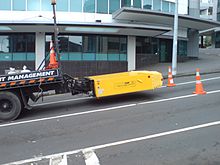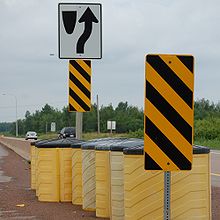- Impact attenuator
-
An impact attenuator, also known as a crash cushion or crash attenuator or cowboy cushions, is a device intended to reduce the damage done to structures, vehicles, and motorists resulting from a motor vehicle collision. Impact attenuators are designed to absorb the errant vehicle's kinetic energy and/or redirect the vehicle away from the hazard,[1] and from roadway machinery or workers.
Contents
Types
Overview
 An impact attenuator mounted to a truck in Auckland.
An impact attenuator mounted to a truck in Auckland.
Impact attenuators are usually placed in front of fixed structures near freeways, such as gore points, Jersey barrier introductions, or overpass supports. Temporary versions can be used for road construction projects.
Impact attenuators can be categorized by the method used to dissipate kinetic energy:
- Momentum transfer. Many early models used successive rows of= sand- or water filled barrels or modules. Momentum is transferred to the sand or water, reducing the speed of the impacting vehicle.
- Material deformation. Many newer attenuators use crushable materials that create a crumple zone, absorbing energy. Others flatten a corrugated steel guard rail section, or split a steel box beam.
- Friction. Some attenuators work by forcing a steel cable or strap through an angled slot or tube, converting kinetic energy into heat.
Truck-mounted versions (TMA), similar to railcar buffers, can be deployed on vehicles that are prone to being struck from behind, such as snow plows and road construction or maintenance vehicles. When deploying a truck-mounted attenuator, the work zone supervisor must recall that the attenuator may not completely absorb the energy of the collision. The truck may be propelled forward by the crash. Work zone regulations often specify a minimum buffer distance between the attenuator truck and the work area, and a minimum mass for the truck, to minimize the chances that the truck will be pushed forward into the workers or machinery it is meant to protect. This is especially important in mobile work zones, where the truck's parking brake may not be engaged.
In the United States, impact attenuators are tested and classified according to AASHTO Manual for Assessing Safety Hardware (MASH), which superseded the Federal Highway Administration NCHRP Report 350. Classification is based on the maximum speed of a vehicle during a collision for which the attenuator is designed.
Fitch Barrier
A Fitch Barrier is a type of impact attenuator which is essentially a plastic barrel filled with sand or water, usually yellow colored with a black lid.
The "Fitch Highway Barrier System", invented by race car driver John Fitch, comprises a series of such impact attenuators often found in a triangular arrangement at the tip of a guardrail between a highway and an exit lane (the area known as the gore), along the most probable line of impact. The barriers in front contain the least sand, with each successive barrel containing more; so that when a vehicle collides with the barrels they shatter, the kinetic energy is dissipated by scattering the sand, and the vehicle decelerates smoothly instead of violently striking a solid obstruction, reducing the risk of injury to the occupants.
Fitch barriers are widely popular due to their effectiveness, low cost, and ease of setup and repair or replacement. Since first being used in the late 1960s, it is estimated that they have saved as many as 17,000 lives.[2]
Fitch has stated that the design was inspired by sand-filled fuel cans which he used to protect his tent from strafing during World War II. [3]
See also
References
Categories:- Road safety
- Road infrastructure
- Road stubs
Wikimedia Foundation. 2010.

